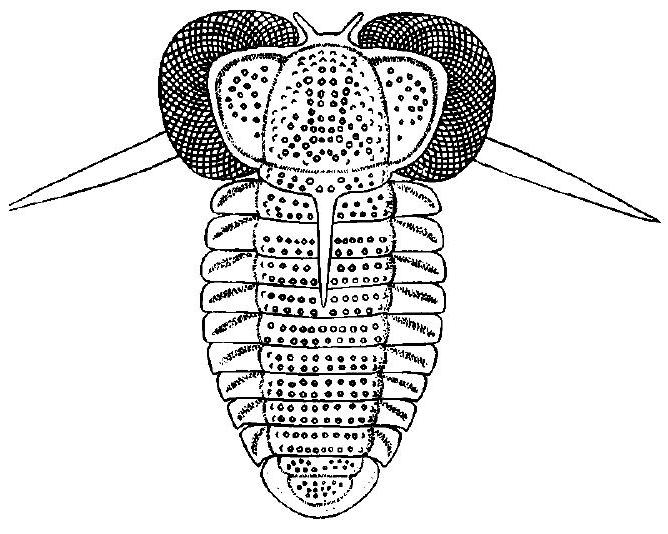Welcome to the Treatise on Invertebrate Paleontology!
Please enter a genera name to retrieve more information.

Telephina
Classification
Phylum:
Arthropoda
Subphylum:
Trilobitomorpha
Class:
Trilobita
Order:
Ptychopariida
Suborder:
Ptychopariina
Superfamily:
Komaspidacea
Family:
Telephinidae
Formal Genus Name and Reference:
Telephina Marek, 1952, [pro Telephus Barrande, 1852 (non Telephus GISTEL, 1848)]
Type Species:
Telephus fractus BARRANDE, 1852
Images
(Click to enlarge in a new window)
Fig. 220. T. spinifera (Ullich), M.Ord., Va.-Tenn., exoskel. (reconstr.), x2.5 (496n).
Synonyms
Geographic Distribution
E.N.Am.-W.Eu.-Austral.
Age Range
Beginning Stage in Treatise Usage:
M.Ord.
Beginning International Stage:
Dapingian
Fraction Up In Beginning Stage:
0
Beginning Date:
471.26
Ending Stage in Treatise Usage:
U.Ord.
Ending International Stage:
Hirnantian
Fraction Up In Ending Stage:
100
Ending Date:
443.07
Description
Characters of family = Exoskeleton elongate elliptical in outline except for projecting genal spines, micropygous. Cephalon convex, wider than long; convex glabella narrowing forward; posterior glabellar furrows may be represented by short longitudinal depressions and anterior pair of furrows by smooth area; pair of spines may occur on frontal lobe; occipital ring convex, commonly with backwardly directed median spine; convex eye surfaces forming large part of librigenae, long and curved, with many tiny facets, enclosing crescentic palpebral lobe with prominent ring; narrow cephalic border outside eye lobes and extended anteriorly; short, forward and slightly downwardly directed pair of spines on anterior border; long slim senal spines, with or without a short spine behind the genals; narrow (exsag.) posterior border, cut by outward and backwardly directed posterior sections of facial sutures. Thorax (known in one species only) of 9 segments, with wide axis, narrow (tr.) pleurae, and broad diagonal pleural furrows. Pygidium small, semicircular in out~ine; convex, axis with 2 or 3 rings that may Clear paired spines; pleural fields narrow, unfurrowed; terminal axial spine may be present. Surface tuberculate, with pattern of anastomosing raised lines (302).
References
Museum or Author Information
Classification
Phylum:
Arthropoda
Subphylum:
Trilobitomorpha
Class:
Trilobita
Order:
Ptychopariida
Suborder:
Ptychopariina
Superfamily:
Komaspidacea
Family:
Telephinidae
Formal Genus Name and Reference:
Telephina Marek, 1952, [pro Telephus Barrande, 1852 (non Telephus GISTEL, 1848)]
Type Species:
Telephus fractus BARRANDE, 1852
Images
(Click to enlarge in a new window)
Fig. 220. T. spinifera (Ullich), M.Ord., Va.-Tenn., exoskel. (reconstr.), x2.5 (496n).
Synonyms
Geographic Distribution
E.N.Am.-W.Eu.-Austral.
Age Range
Beginning Stage in Treatise Usage:
M.Ord.
Beginning International Stage:
Dapingian
Fraction Up In Beginning Stage:
0
Beginning Date:
471.26
Ending Stage in Treatise Usage:
U.Ord.
Ending International Stage:
Hirnantian
Fraction Up In Ending Stage:
100
Ending Date:
443.07
Description
Characters of family = Exoskeleton elongate elliptical in outline except for projecting genal spines, micropygous. Cephalon convex, wider than long; convex glabella narrowing forward; posterior glabellar furrows may be represented by short longitudinal depressions and anterior pair of furrows by smooth area; pair of spines may occur on frontal lobe; occipital ring convex, commonly with backwardly directed median spine; convex eye surfaces forming large part of librigenae, long and curved, with many tiny facets, enclosing crescentic palpebral lobe with prominent ring; narrow cephalic border outside eye lobes and extended anteriorly; short, forward and slightly downwardly directed pair of spines on anterior border; long slim senal spines, with or without a short spine behind the genals; narrow (exsag.) posterior border, cut by outward and backwardly directed posterior sections of facial sutures. Thorax (known in one species only) of 9 segments, with wide axis, narrow (tr.) pleurae, and broad diagonal pleural furrows. Pygidium small, semicircular in out~ine; convex, axis with 2 or 3 rings that may Clear paired spines; pleural fields narrow, unfurrowed; terminal axial spine may be present. Surface tuberculate, with pattern of anastomosing raised lines (302).
